Strategic Innovation: Solar Power Diffusion in Australia Report
VerifiedAdded on 2022/11/02
|22
|5293
|121
Report
AI Summary
This report investigates the diffusion of solar power and innovation within Australia, focusing on how various factors influence the adoption of solar energy technologies. It begins with an overview of Australia's solar energy landscape, highlighting the country's high solar radiation levels and current energy consumption patterns. The study examines public policies, consumer acceptance, and key terms such as solar energy, solar technology, and diffusion of innovation. It also delves into relevant theories like the Diffusion of Innovation Theory (IDT) and the Technology Acceptance Model (TAM), analyzing the impact of innovation characteristics such as relative advantage, compatibility, complexity, trialability, and observability on the rate of adoption. The report includes an analysis of the diffusion of innovation curve and its application to solar energy in Australia, emphasizing the importance of communication channels and social systems in the adoption process. Furthermore, it provides a detailed discussion of factors that predict the rate of adoption, such as relative advantage, compatibility, complexity, trialability, and observability, offering insights into how these characteristics affect consumer decisions. The report concludes with a comprehensive overview of the theories and themes associated with solar energy in Australia, including the social impact of the IDT and the role of TAM in technology acceptance. It aims to provide a thorough understanding of the diffusion process and its effects on organizational performance within the context of solar energy adoption in Australia.
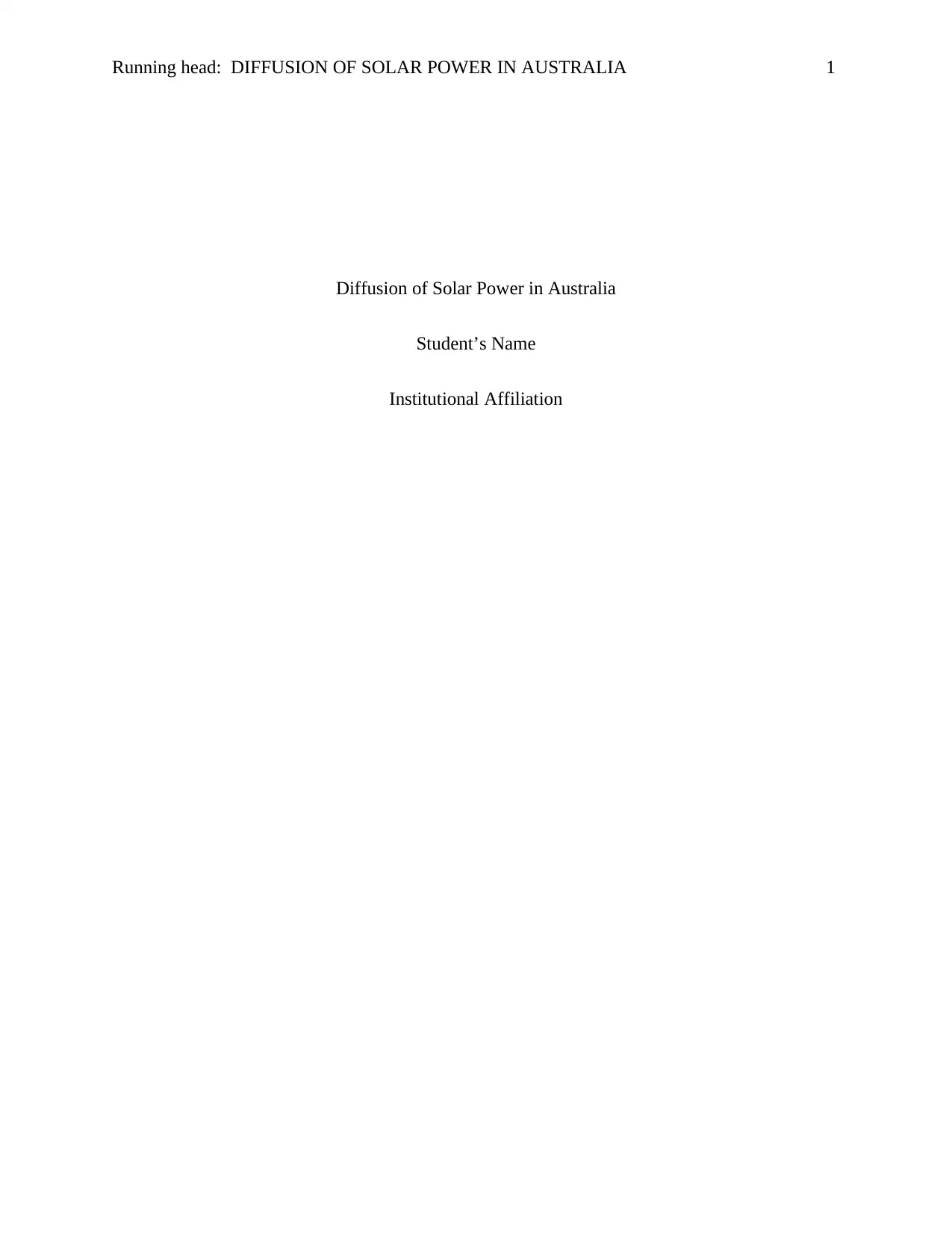
Running head: DIFFUSION OF SOLAR POWER IN AUSTRALIA 1
Diffusion of Solar Power in Australia
Student’s Name
Institutional Affiliation
Diffusion of Solar Power in Australia
Student’s Name
Institutional Affiliation
Paraphrase This Document
Need a fresh take? Get an instant paraphrase of this document with our AI Paraphraser
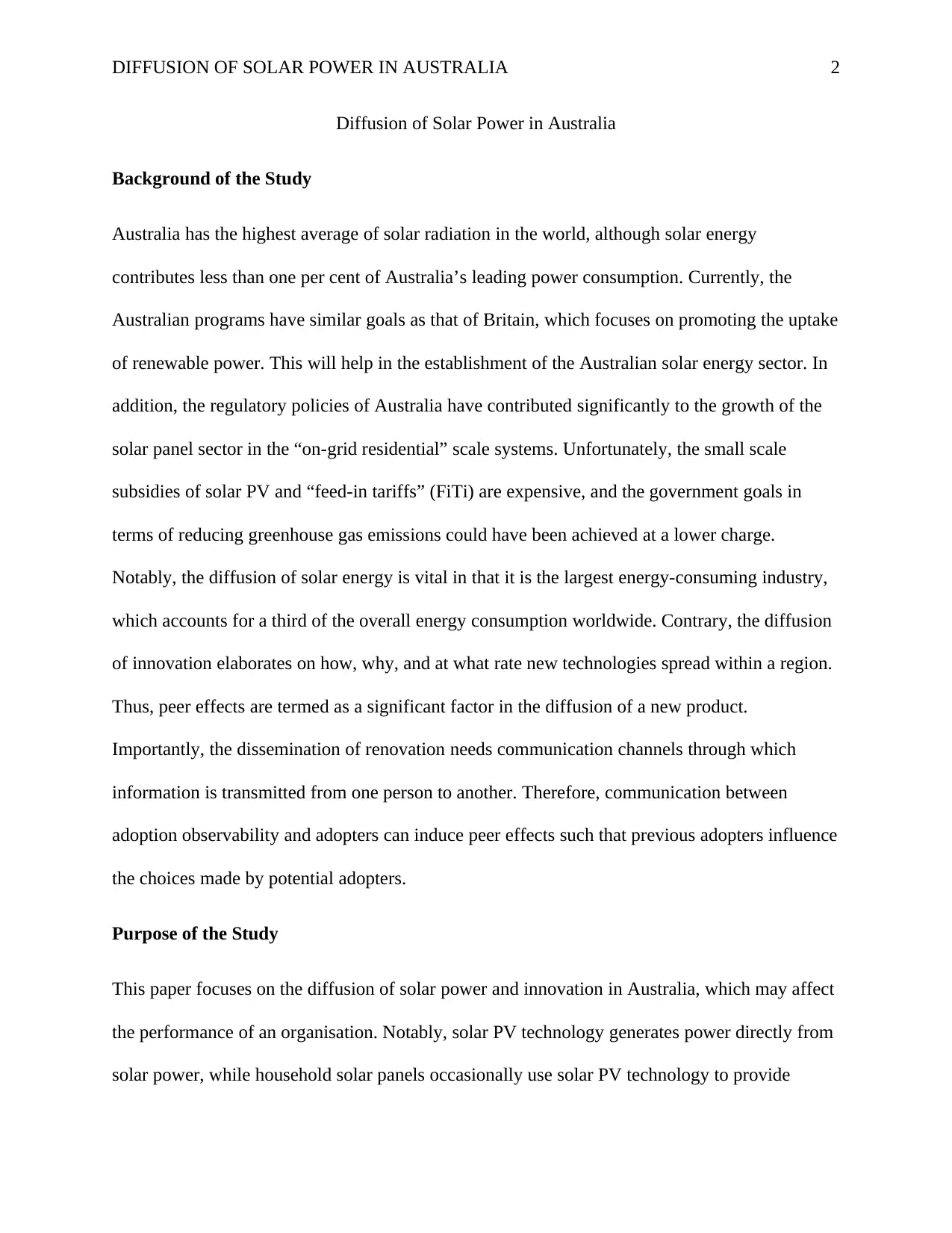
DIFFUSION OF SOLAR POWER IN AUSTRALIA 2
Diffusion of Solar Power in Australia
Background of the Study
Australia has the highest average of solar radiation in the world, although solar energy
contributes less than one per cent of Australia’s leading power consumption. Currently, the
Australian programs have similar goals as that of Britain, which focuses on promoting the uptake
of renewable power. This will help in the establishment of the Australian solar energy sector. In
addition, the regulatory policies of Australia have contributed significantly to the growth of the
solar panel sector in the “on-grid residential” scale systems. Unfortunately, the small scale
subsidies of solar PV and “feed-in tariffs” (FiTi) are expensive, and the government goals in
terms of reducing greenhouse gas emissions could have been achieved at a lower charge.
Notably, the diffusion of solar energy is vital in that it is the largest energy-consuming industry,
which accounts for a third of the overall energy consumption worldwide. Contrary, the diffusion
of innovation elaborates on how, why, and at what rate new technologies spread within a region.
Thus, peer effects are termed as a significant factor in the diffusion of a new product.
Importantly, the dissemination of renovation needs communication channels through which
information is transmitted from one person to another. Therefore, communication between
adoption observability and adopters can induce peer effects such that previous adopters influence
the choices made by potential adopters.
Purpose of the Study
This paper focuses on the diffusion of solar power and innovation in Australia, which may affect
the performance of an organisation. Notably, solar PV technology generates power directly from
solar power, while household solar panels occasionally use solar PV technology to provide
Diffusion of Solar Power in Australia
Background of the Study
Australia has the highest average of solar radiation in the world, although solar energy
contributes less than one per cent of Australia’s leading power consumption. Currently, the
Australian programs have similar goals as that of Britain, which focuses on promoting the uptake
of renewable power. This will help in the establishment of the Australian solar energy sector. In
addition, the regulatory policies of Australia have contributed significantly to the growth of the
solar panel sector in the “on-grid residential” scale systems. Unfortunately, the small scale
subsidies of solar PV and “feed-in tariffs” (FiTi) are expensive, and the government goals in
terms of reducing greenhouse gas emissions could have been achieved at a lower charge.
Notably, the diffusion of solar energy is vital in that it is the largest energy-consuming industry,
which accounts for a third of the overall energy consumption worldwide. Contrary, the diffusion
of innovation elaborates on how, why, and at what rate new technologies spread within a region.
Thus, peer effects are termed as a significant factor in the diffusion of a new product.
Importantly, the dissemination of renovation needs communication channels through which
information is transmitted from one person to another. Therefore, communication between
adoption observability and adopters can induce peer effects such that previous adopters influence
the choices made by potential adopters.
Purpose of the Study
This paper focuses on the diffusion of solar power and innovation in Australia, which may affect
the performance of an organisation. Notably, solar PV technology generates power directly from
solar power, while household solar panels occasionally use solar PV technology to provide
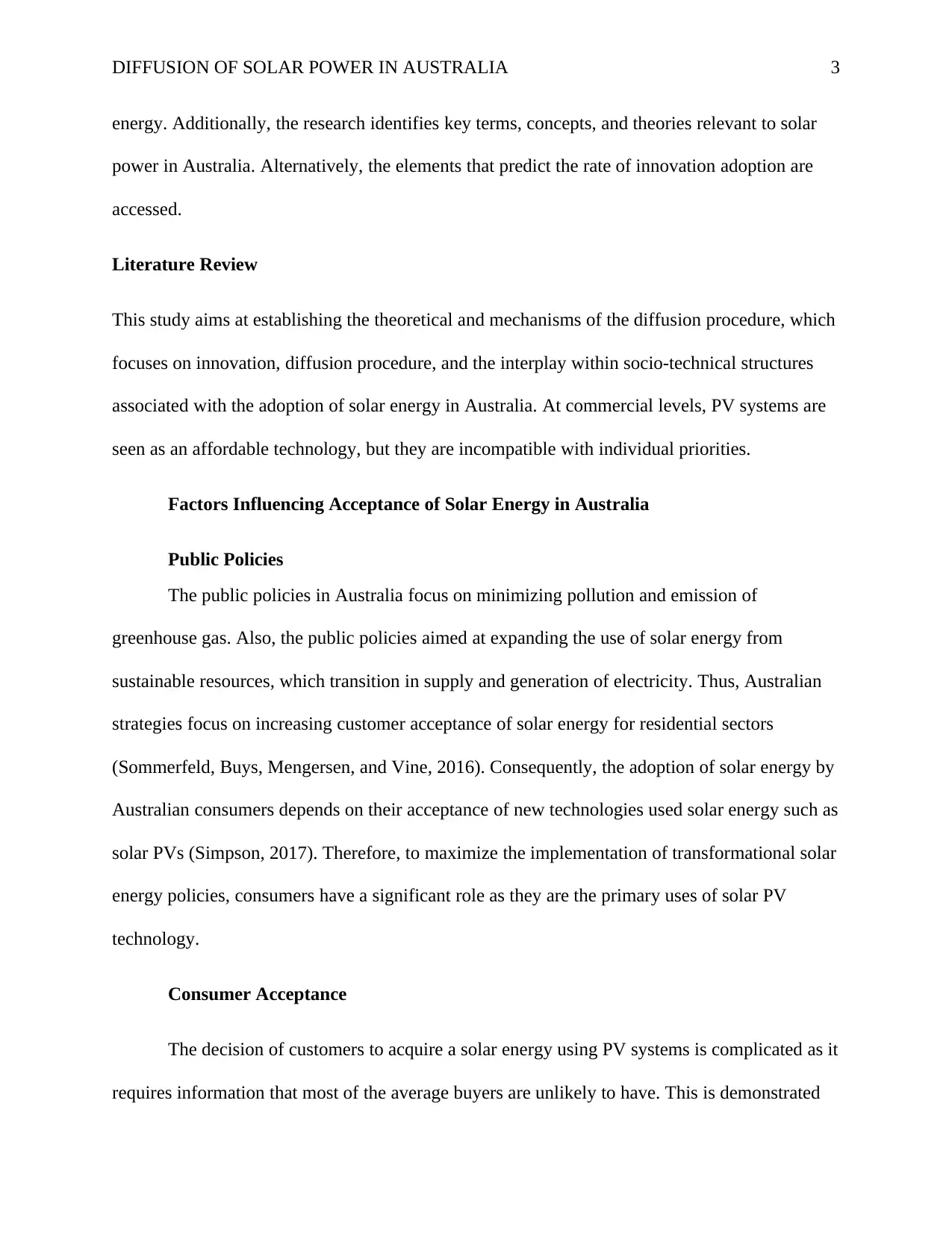
DIFFUSION OF SOLAR POWER IN AUSTRALIA 3
energy. Additionally, the research identifies key terms, concepts, and theories relevant to solar
power in Australia. Alternatively, the elements that predict the rate of innovation adoption are
accessed.
Literature Review
This study aims at establishing the theoretical and mechanisms of the diffusion procedure, which
focuses on innovation, diffusion procedure, and the interplay within socio-technical structures
associated with the adoption of solar energy in Australia. At commercial levels, PV systems are
seen as an affordable technology, but they are incompatible with individual priorities.
Factors Influencing Acceptance of Solar Energy in Australia
Public Policies
The public policies in Australia focus on minimizing pollution and emission of
greenhouse gas. Also, the public policies aimed at expanding the use of solar energy from
sustainable resources, which transition in supply and generation of electricity. Thus, Australian
strategies focus on increasing customer acceptance of solar energy for residential sectors
(Sommerfeld, Buys, Mengersen, and Vine, 2016). Consequently, the adoption of solar energy by
Australian consumers depends on their acceptance of new technologies used solar energy such as
solar PVs (Simpson, 2017). Therefore, to maximize the implementation of transformational solar
energy policies, consumers have a significant role as they are the primary uses of solar PV
technology.
Consumer Acceptance
The decision of customers to acquire a solar energy using PV systems is complicated as it
requires information that most of the average buyers are unlikely to have. This is demonstrated
energy. Additionally, the research identifies key terms, concepts, and theories relevant to solar
power in Australia. Alternatively, the elements that predict the rate of innovation adoption are
accessed.
Literature Review
This study aims at establishing the theoretical and mechanisms of the diffusion procedure, which
focuses on innovation, diffusion procedure, and the interplay within socio-technical structures
associated with the adoption of solar energy in Australia. At commercial levels, PV systems are
seen as an affordable technology, but they are incompatible with individual priorities.
Factors Influencing Acceptance of Solar Energy in Australia
Public Policies
The public policies in Australia focus on minimizing pollution and emission of
greenhouse gas. Also, the public policies aimed at expanding the use of solar energy from
sustainable resources, which transition in supply and generation of electricity. Thus, Australian
strategies focus on increasing customer acceptance of solar energy for residential sectors
(Sommerfeld, Buys, Mengersen, and Vine, 2016). Consequently, the adoption of solar energy by
Australian consumers depends on their acceptance of new technologies used solar energy such as
solar PVs (Simpson, 2017). Therefore, to maximize the implementation of transformational solar
energy policies, consumers have a significant role as they are the primary uses of solar PV
technology.
Consumer Acceptance
The decision of customers to acquire a solar energy using PV systems is complicated as it
requires information that most of the average buyers are unlikely to have. This is demonstrated
⊘ This is a preview!⊘
Do you want full access?
Subscribe today to unlock all pages.

Trusted by 1+ million students worldwide
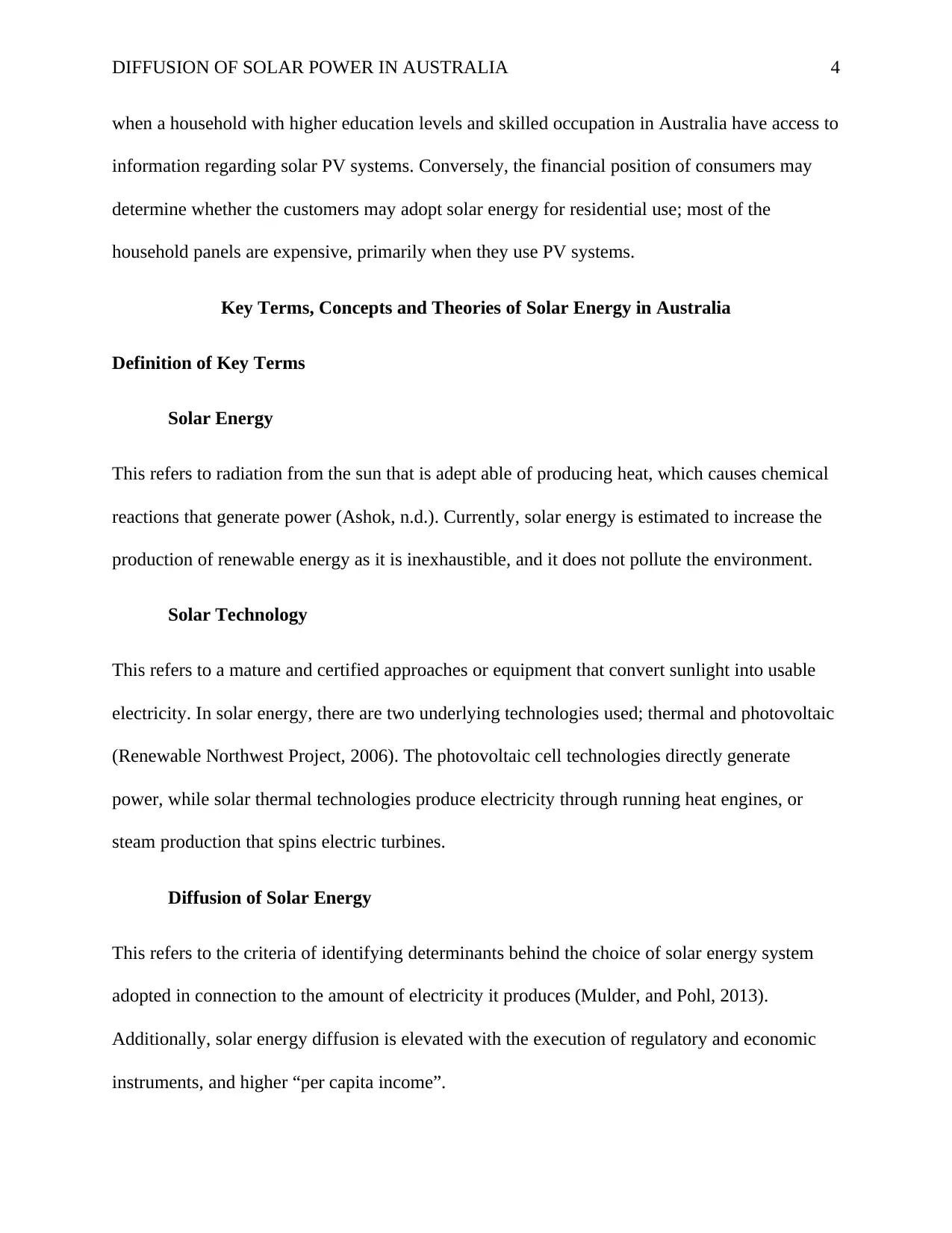
DIFFUSION OF SOLAR POWER IN AUSTRALIA 4
when a household with higher education levels and skilled occupation in Australia have access to
information regarding solar PV systems. Conversely, the financial position of consumers may
determine whether the customers may adopt solar energy for residential use; most of the
household panels are expensive, primarily when they use PV systems.
Key Terms, Concepts and Theories of Solar Energy in Australia
Definition of Key Terms
Solar Energy
This refers to radiation from the sun that is adept able of producing heat, which causes chemical
reactions that generate power (Ashok, n.d.). Currently, solar energy is estimated to increase the
production of renewable energy as it is inexhaustible, and it does not pollute the environment.
Solar Technology
This refers to a mature and certified approaches or equipment that convert sunlight into usable
electricity. In solar energy, there are two underlying technologies used; thermal and photovoltaic
(Renewable Northwest Project, 2006). The photovoltaic cell technologies directly generate
power, while solar thermal technologies produce electricity through running heat engines, or
steam production that spins electric turbines.
Diffusion of Solar Energy
This refers to the criteria of identifying determinants behind the choice of solar energy system
adopted in connection to the amount of electricity it produces (Mulder, and Pohl, 2013).
Additionally, solar energy diffusion is elevated with the execution of regulatory and economic
instruments, and higher “per capita income”.
when a household with higher education levels and skilled occupation in Australia have access to
information regarding solar PV systems. Conversely, the financial position of consumers may
determine whether the customers may adopt solar energy for residential use; most of the
household panels are expensive, primarily when they use PV systems.
Key Terms, Concepts and Theories of Solar Energy in Australia
Definition of Key Terms
Solar Energy
This refers to radiation from the sun that is adept able of producing heat, which causes chemical
reactions that generate power (Ashok, n.d.). Currently, solar energy is estimated to increase the
production of renewable energy as it is inexhaustible, and it does not pollute the environment.
Solar Technology
This refers to a mature and certified approaches or equipment that convert sunlight into usable
electricity. In solar energy, there are two underlying technologies used; thermal and photovoltaic
(Renewable Northwest Project, 2006). The photovoltaic cell technologies directly generate
power, while solar thermal technologies produce electricity through running heat engines, or
steam production that spins electric turbines.
Diffusion of Solar Energy
This refers to the criteria of identifying determinants behind the choice of solar energy system
adopted in connection to the amount of electricity it produces (Mulder, and Pohl, 2013).
Additionally, solar energy diffusion is elevated with the execution of regulatory and economic
instruments, and higher “per capita income”.
Paraphrase This Document
Need a fresh take? Get an instant paraphrase of this document with our AI Paraphraser
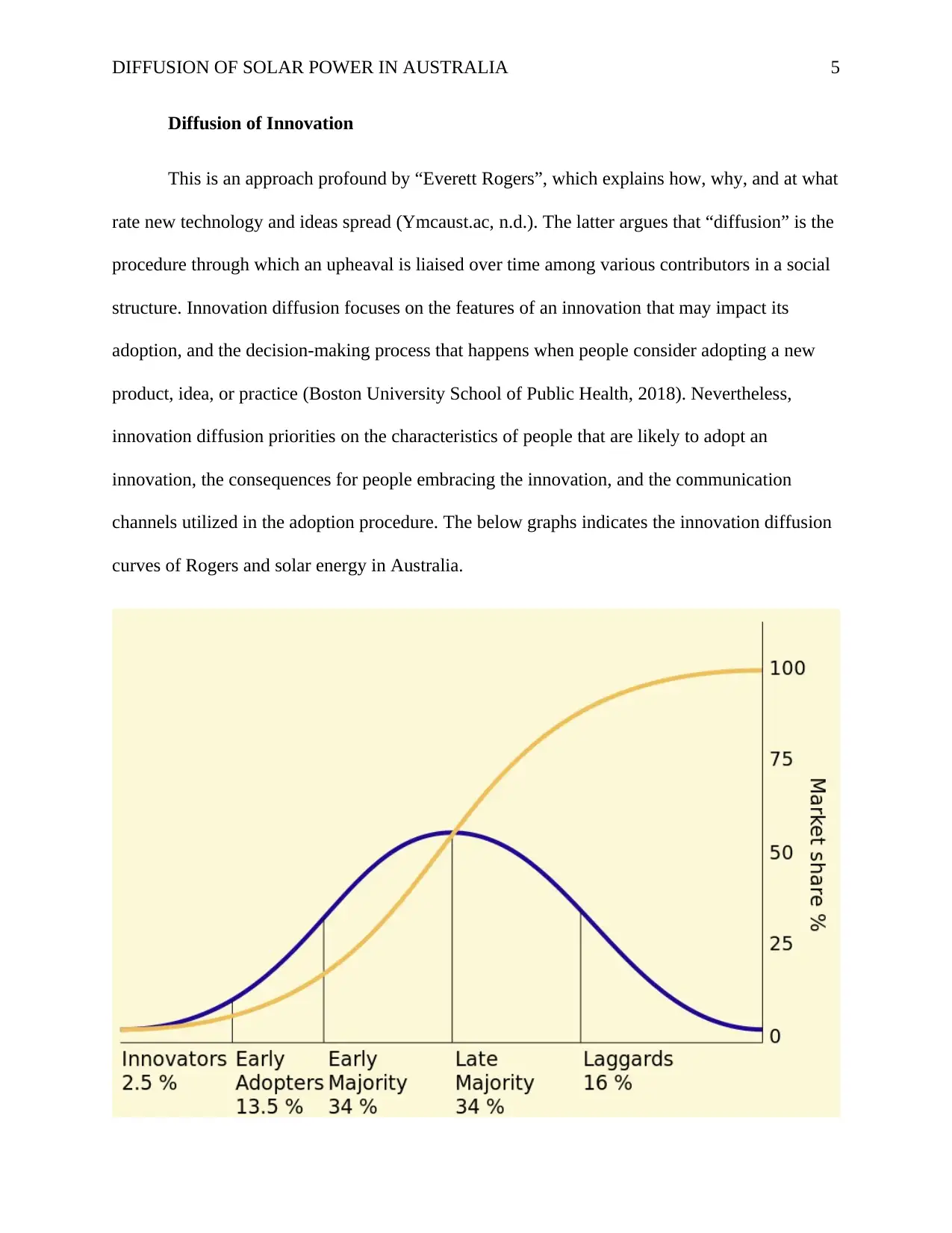
DIFFUSION OF SOLAR POWER IN AUSTRALIA 5
Diffusion of Innovation
This is an approach profound by “Everett Rogers”, which explains how, why, and at what
rate new technology and ideas spread (Ymcaust.ac, n.d.). The latter argues that “diffusion” is the
procedure through which an upheaval is liaised over time among various contributors in a social
structure. Innovation diffusion focuses on the features of an innovation that may impact its
adoption, and the decision-making process that happens when people consider adopting a new
product, idea, or practice (Boston University School of Public Health, 2018). Nevertheless,
innovation diffusion priorities on the characteristics of people that are likely to adopt an
innovation, the consequences for people embracing the innovation, and the communication
channels utilized in the adoption procedure. The below graphs indicates the innovation diffusion
curves of Rogers and solar energy in Australia.
Diffusion of Innovation
This is an approach profound by “Everett Rogers”, which explains how, why, and at what
rate new technology and ideas spread (Ymcaust.ac, n.d.). The latter argues that “diffusion” is the
procedure through which an upheaval is liaised over time among various contributors in a social
structure. Innovation diffusion focuses on the features of an innovation that may impact its
adoption, and the decision-making process that happens when people consider adopting a new
product, idea, or practice (Boston University School of Public Health, 2018). Nevertheless,
innovation diffusion priorities on the characteristics of people that are likely to adopt an
innovation, the consequences for people embracing the innovation, and the communication
channels utilized in the adoption procedure. The below graphs indicates the innovation diffusion
curves of Rogers and solar energy in Australia.
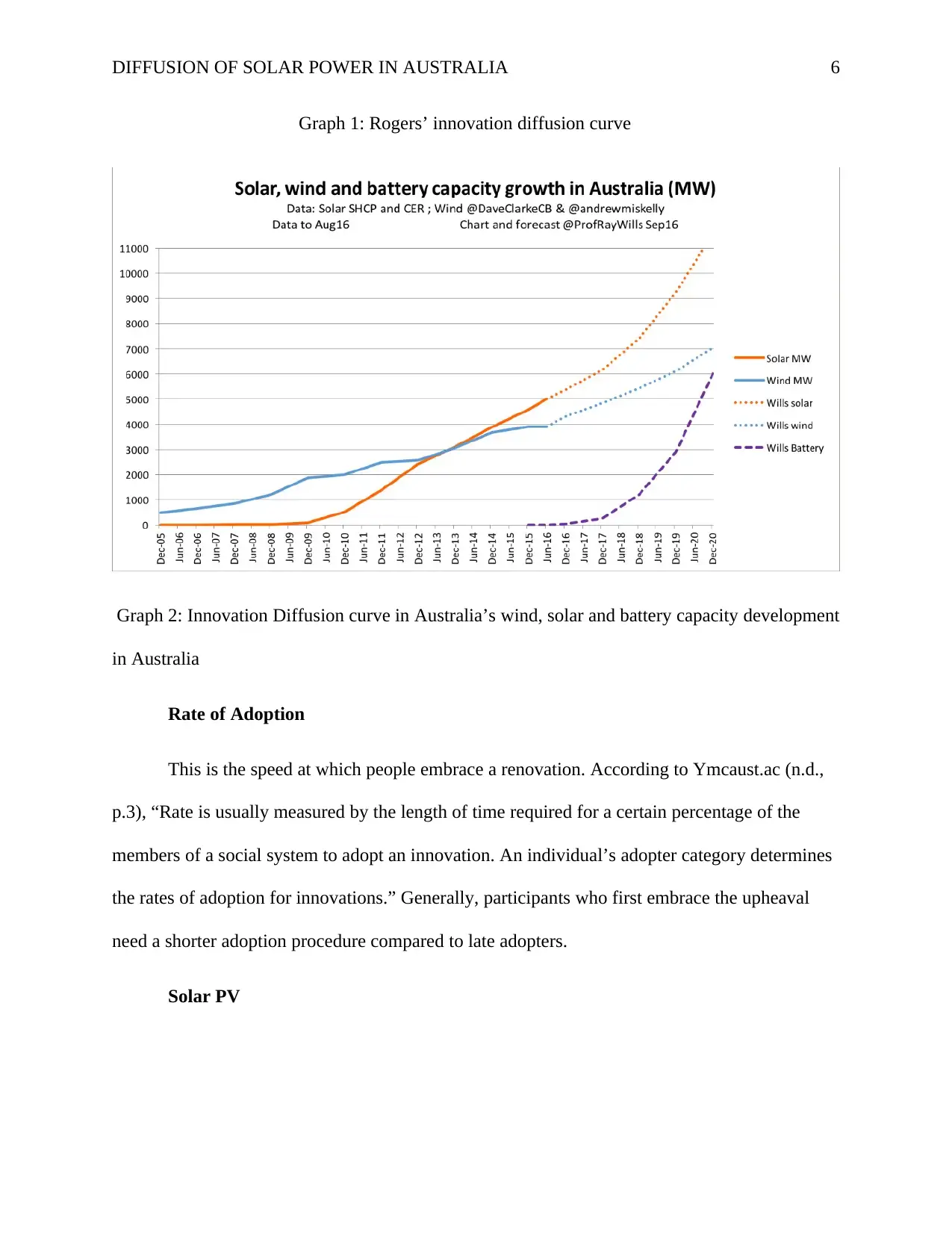
DIFFUSION OF SOLAR POWER IN AUSTRALIA 6
Graph 1: Rogers’ innovation diffusion curve
Graph 2: Innovation Diffusion curve in Australia’s wind, solar and battery capacity development
in Australia
Rate of Adoption
This is the speed at which people embrace a renovation. According to Ymcaust.ac (n.d.,
p.3), “Rate is usually measured by the length of time required for a certain percentage of the
members of a social system to adopt an innovation. An individual’s adopter category determines
the rates of adoption for innovations.” Generally, participants who first embrace the upheaval
need a shorter adoption procedure compared to late adopters.
Solar PV
Graph 1: Rogers’ innovation diffusion curve
Graph 2: Innovation Diffusion curve in Australia’s wind, solar and battery capacity development
in Australia
Rate of Adoption
This is the speed at which people embrace a renovation. According to Ymcaust.ac (n.d.,
p.3), “Rate is usually measured by the length of time required for a certain percentage of the
members of a social system to adopt an innovation. An individual’s adopter category determines
the rates of adoption for innovations.” Generally, participants who first embrace the upheaval
need a shorter adoption procedure compared to late adopters.
Solar PV
⊘ This is a preview!⊘
Do you want full access?
Subscribe today to unlock all pages.

Trusted by 1+ million students worldwide
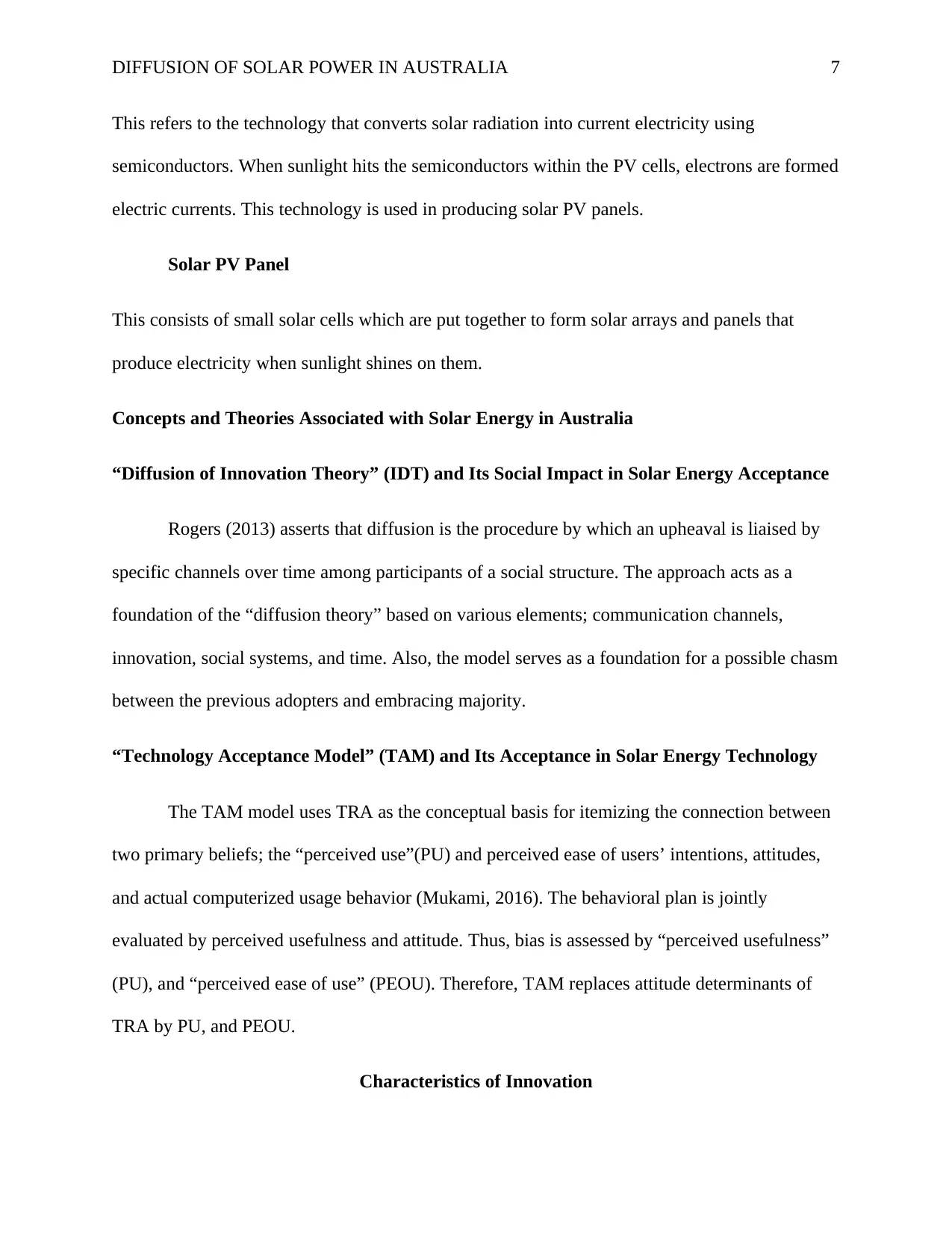
DIFFUSION OF SOLAR POWER IN AUSTRALIA 7
This refers to the technology that converts solar radiation into current electricity using
semiconductors. When sunlight hits the semiconductors within the PV cells, electrons are formed
electric currents. This technology is used in producing solar PV panels.
Solar PV Panel
This consists of small solar cells which are put together to form solar arrays and panels that
produce electricity when sunlight shines on them.
Concepts and Theories Associated with Solar Energy in Australia
“Diffusion of Innovation Theory” (IDT) and Its Social Impact in Solar Energy Acceptance
Rogers (2013) asserts that diffusion is the procedure by which an upheaval is liaised by
specific channels over time among participants of a social structure. The approach acts as a
foundation of the “diffusion theory” based on various elements; communication channels,
innovation, social systems, and time. Also, the model serves as a foundation for a possible chasm
between the previous adopters and embracing majority.
“Technology Acceptance Model” (TAM) and Its Acceptance in Solar Energy Technology
The TAM model uses TRA as the conceptual basis for itemizing the connection between
two primary beliefs; the “perceived use”(PU) and perceived ease of users’ intentions, attitudes,
and actual computerized usage behavior (Mukami, 2016). The behavioral plan is jointly
evaluated by perceived usefulness and attitude. Thus, bias is assessed by “perceived usefulness”
(PU), and “perceived ease of use” (PEOU). Therefore, TAM replaces attitude determinants of
TRA by PU, and PEOU.
Characteristics of Innovation
This refers to the technology that converts solar radiation into current electricity using
semiconductors. When sunlight hits the semiconductors within the PV cells, electrons are formed
electric currents. This technology is used in producing solar PV panels.
Solar PV Panel
This consists of small solar cells which are put together to form solar arrays and panels that
produce electricity when sunlight shines on them.
Concepts and Theories Associated with Solar Energy in Australia
“Diffusion of Innovation Theory” (IDT) and Its Social Impact in Solar Energy Acceptance
Rogers (2013) asserts that diffusion is the procedure by which an upheaval is liaised by
specific channels over time among participants of a social structure. The approach acts as a
foundation of the “diffusion theory” based on various elements; communication channels,
innovation, social systems, and time. Also, the model serves as a foundation for a possible chasm
between the previous adopters and embracing majority.
“Technology Acceptance Model” (TAM) and Its Acceptance in Solar Energy Technology
The TAM model uses TRA as the conceptual basis for itemizing the connection between
two primary beliefs; the “perceived use”(PU) and perceived ease of users’ intentions, attitudes,
and actual computerized usage behavior (Mukami, 2016). The behavioral plan is jointly
evaluated by perceived usefulness and attitude. Thus, bias is assessed by “perceived usefulness”
(PU), and “perceived ease of use” (PEOU). Therefore, TAM replaces attitude determinants of
TRA by PU, and PEOU.
Characteristics of Innovation
Paraphrase This Document
Need a fresh take? Get an instant paraphrase of this document with our AI Paraphraser
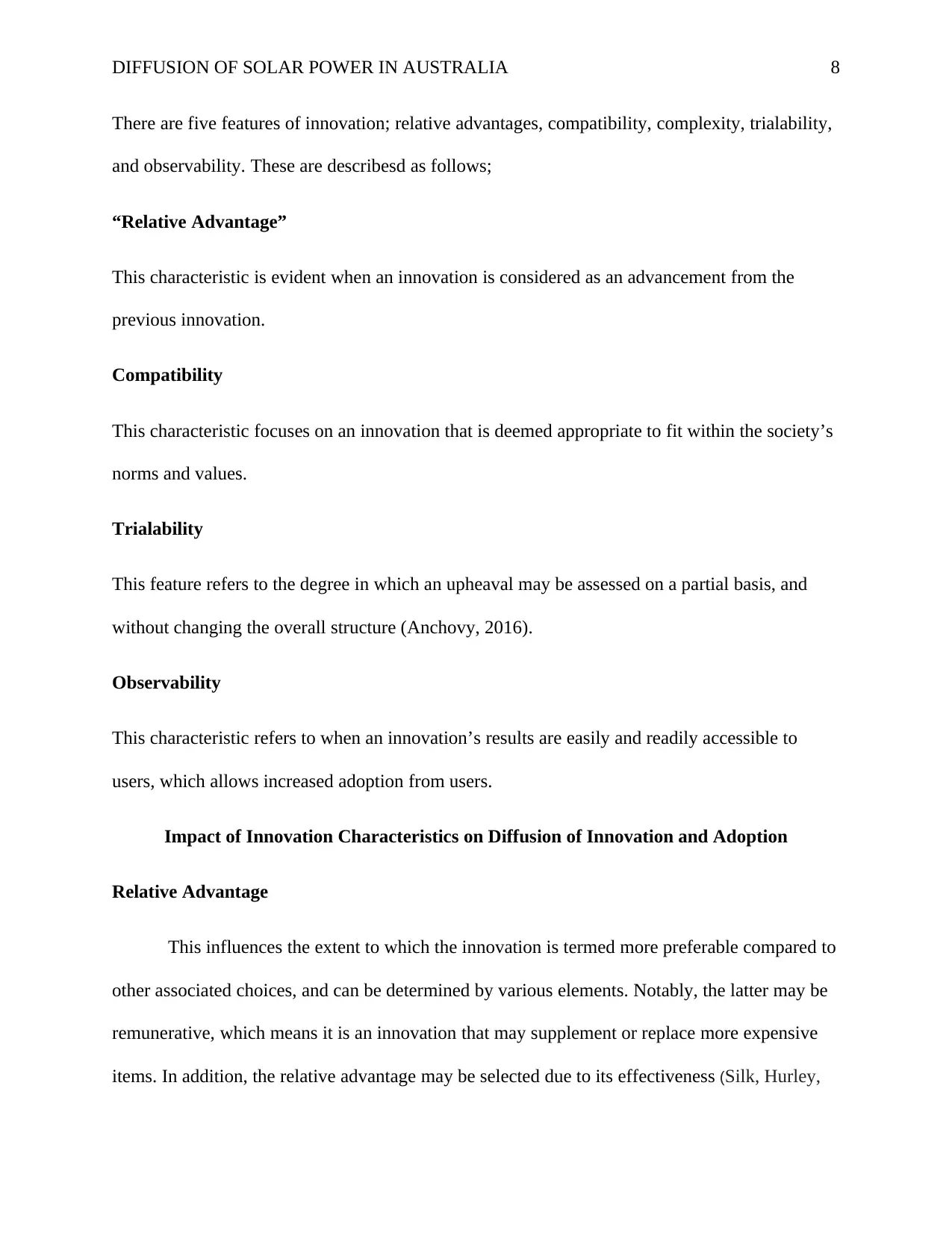
DIFFUSION OF SOLAR POWER IN AUSTRALIA 8
There are five features of innovation; relative advantages, compatibility, complexity, trialability,
and observability. These are describesd as follows;
“Relative Advantage”
This characteristic is evident when an innovation is considered as an advancement from the
previous innovation.
Compatibility
This characteristic focuses on an innovation that is deemed appropriate to fit within the society’s
norms and values.
Trialability
This feature refers to the degree in which an upheaval may be assessed on a partial basis, and
without changing the overall structure (Anchovy, 2016).
Observability
This characteristic refers to when an innovation’s results are easily and readily accessible to
users, which allows increased adoption from users.
Impact of Innovation Characteristics on Diffusion of Innovation and Adoption
Relative Advantage
This influences the extent to which the innovation is termed more preferable compared to
other associated choices, and can be determined by various elements. Notably, the latter may be
remunerative, which means it is an innovation that may supplement or replace more expensive
items. In addition, the relative advantage may be selected due to its effectiveness (Silk, Hurley,
There are five features of innovation; relative advantages, compatibility, complexity, trialability,
and observability. These are describesd as follows;
“Relative Advantage”
This characteristic is evident when an innovation is considered as an advancement from the
previous innovation.
Compatibility
This characteristic focuses on an innovation that is deemed appropriate to fit within the society’s
norms and values.
Trialability
This feature refers to the degree in which an upheaval may be assessed on a partial basis, and
without changing the overall structure (Anchovy, 2016).
Observability
This characteristic refers to when an innovation’s results are easily and readily accessible to
users, which allows increased adoption from users.
Impact of Innovation Characteristics on Diffusion of Innovation and Adoption
Relative Advantage
This influences the extent to which the innovation is termed more preferable compared to
other associated choices, and can be determined by various elements. Notably, the latter may be
remunerative, which means it is an innovation that may supplement or replace more expensive
items. In addition, the relative advantage may be selected due to its effectiveness (Silk, Hurley,
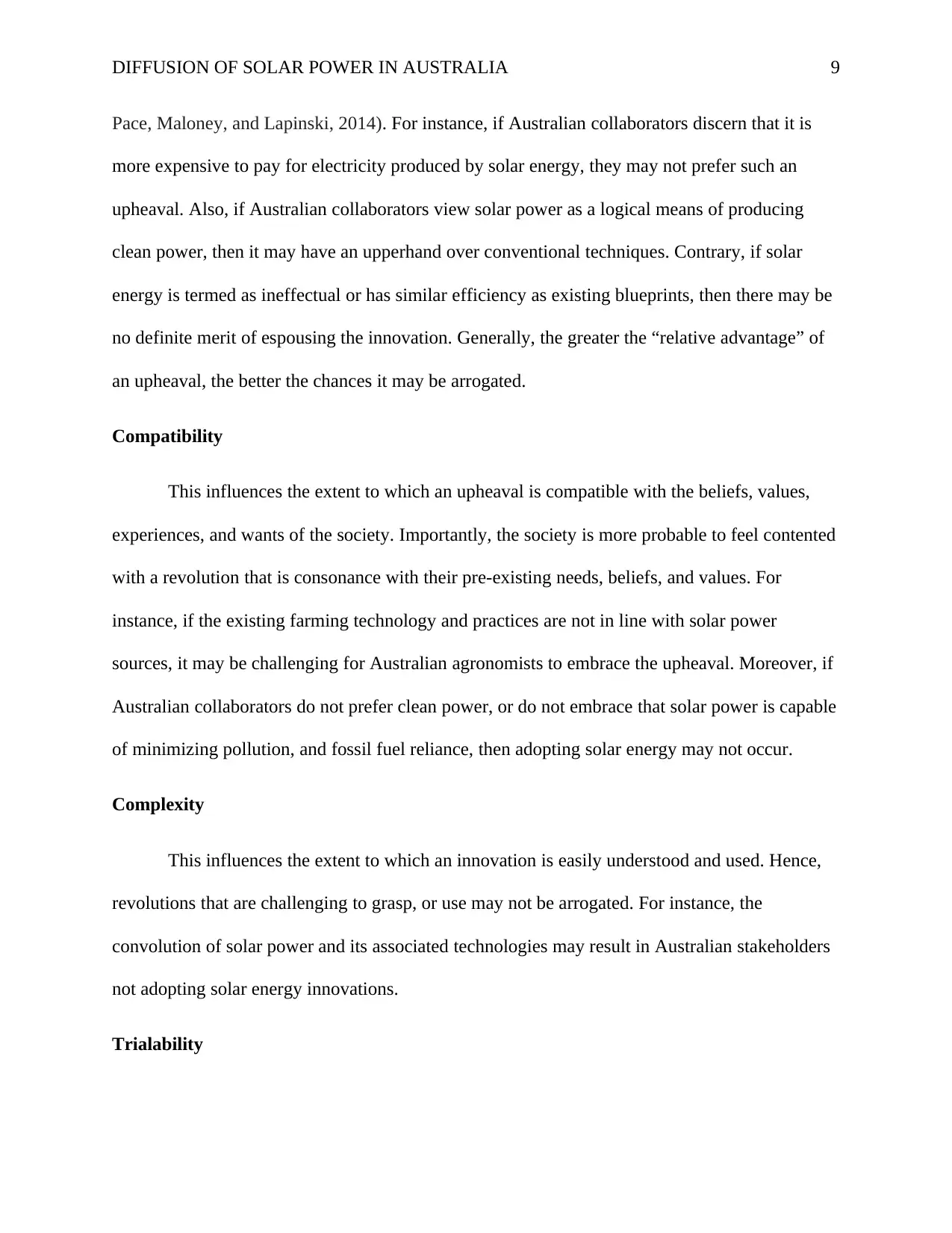
DIFFUSION OF SOLAR POWER IN AUSTRALIA 9
Pace, Maloney, and Lapinski, 2014). For instance, if Australian collaborators discern that it is
more expensive to pay for electricity produced by solar energy, they may not prefer such an
upheaval. Also, if Australian collaborators view solar power as a logical means of producing
clean power, then it may have an upperhand over conventional techniques. Contrary, if solar
energy is termed as ineffectual or has similar efficiency as existing blueprints, then there may be
no definite merit of espousing the innovation. Generally, the greater the “relative advantage” of
an upheaval, the better the chances it may be arrogated.
Compatibility
This influences the extent to which an upheaval is compatible with the beliefs, values,
experiences, and wants of the society. Importantly, the society is more probable to feel contented
with a revolution that is consonance with their pre-existing needs, beliefs, and values. For
instance, if the existing farming technology and practices are not in line with solar power
sources, it may be challenging for Australian agronomists to embrace the upheaval. Moreover, if
Australian collaborators do not prefer clean power, or do not embrace that solar power is capable
of minimizing pollution, and fossil fuel reliance, then adopting solar energy may not occur.
Complexity
This influences the extent to which an innovation is easily understood and used. Hence,
revolutions that are challenging to grasp, or use may not be arrogated. For instance, the
convolution of solar power and its associated technologies may result in Australian stakeholders
not adopting solar energy innovations.
Trialability
Pace, Maloney, and Lapinski, 2014). For instance, if Australian collaborators discern that it is
more expensive to pay for electricity produced by solar energy, they may not prefer such an
upheaval. Also, if Australian collaborators view solar power as a logical means of producing
clean power, then it may have an upperhand over conventional techniques. Contrary, if solar
energy is termed as ineffectual or has similar efficiency as existing blueprints, then there may be
no definite merit of espousing the innovation. Generally, the greater the “relative advantage” of
an upheaval, the better the chances it may be arrogated.
Compatibility
This influences the extent to which an upheaval is compatible with the beliefs, values,
experiences, and wants of the society. Importantly, the society is more probable to feel contented
with a revolution that is consonance with their pre-existing needs, beliefs, and values. For
instance, if the existing farming technology and practices are not in line with solar power
sources, it may be challenging for Australian agronomists to embrace the upheaval. Moreover, if
Australian collaborators do not prefer clean power, or do not embrace that solar power is capable
of minimizing pollution, and fossil fuel reliance, then adopting solar energy may not occur.
Complexity
This influences the extent to which an innovation is easily understood and used. Hence,
revolutions that are challenging to grasp, or use may not be arrogated. For instance, the
convolution of solar power and its associated technologies may result in Australian stakeholders
not adopting solar energy innovations.
Trialability
⊘ This is a preview!⊘
Do you want full access?
Subscribe today to unlock all pages.

Trusted by 1+ million students worldwide
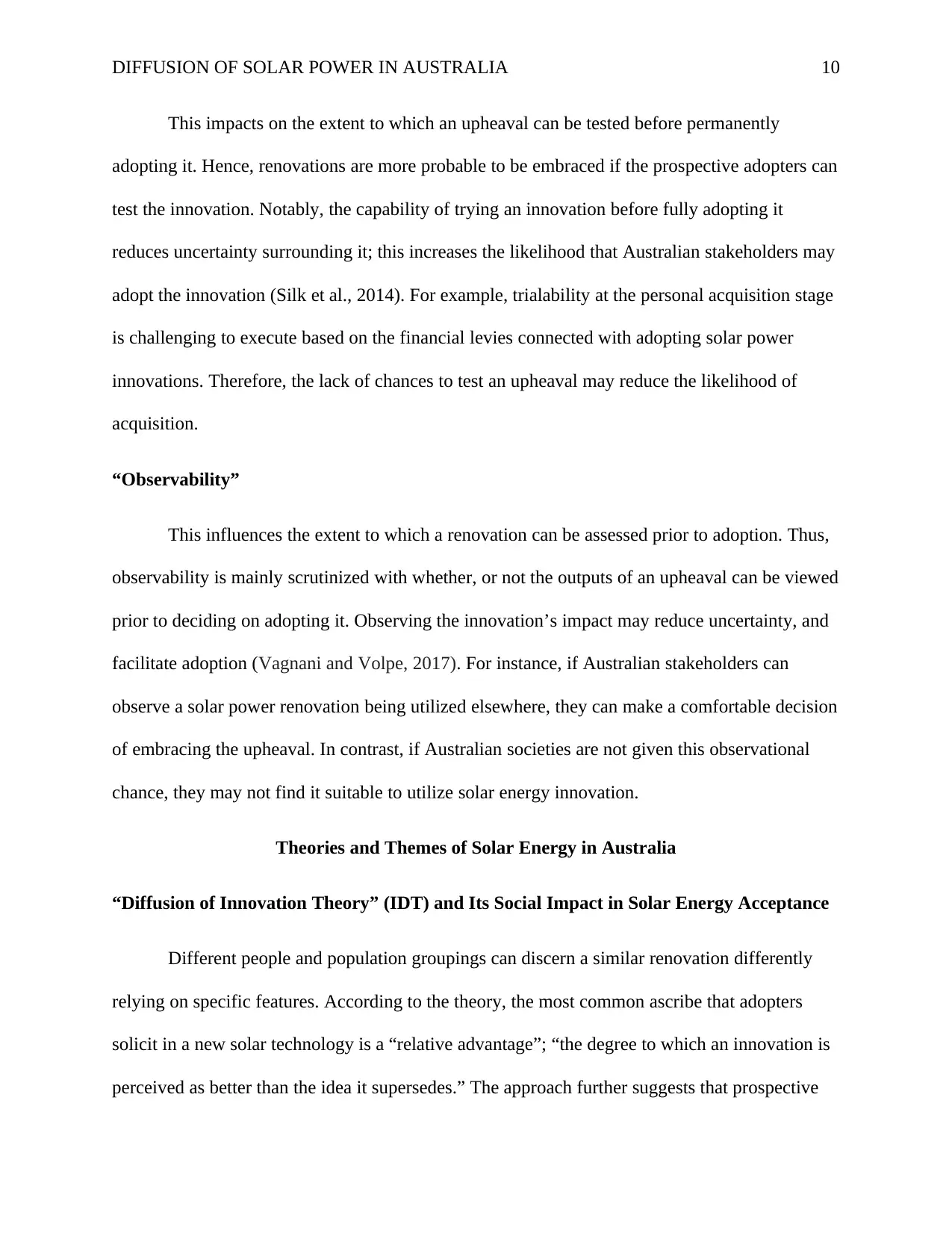
DIFFUSION OF SOLAR POWER IN AUSTRALIA 10
This impacts on the extent to which an upheaval can be tested before permanently
adopting it. Hence, renovations are more probable to be embraced if the prospective adopters can
test the innovation. Notably, the capability of trying an innovation before fully adopting it
reduces uncertainty surrounding it; this increases the likelihood that Australian stakeholders may
adopt the innovation (Silk et al., 2014). For example, trialability at the personal acquisition stage
is challenging to execute based on the financial levies connected with adopting solar power
innovations. Therefore, the lack of chances to test an upheaval may reduce the likelihood of
acquisition.
“Observability”
This influences the extent to which a renovation can be assessed prior to adoption. Thus,
observability is mainly scrutinized with whether, or not the outputs of an upheaval can be viewed
prior to deciding on adopting it. Observing the innovation’s impact may reduce uncertainty, and
facilitate adoption (Vagnani and Volpe, 2017). For instance, if Australian stakeholders can
observe a solar power renovation being utilized elsewhere, they can make a comfortable decision
of embracing the upheaval. In contrast, if Australian societies are not given this observational
chance, they may not find it suitable to utilize solar energy innovation.
Theories and Themes of Solar Energy in Australia
“Diffusion of Innovation Theory” (IDT) and Its Social Impact in Solar Energy Acceptance
Different people and population groupings can discern a similar renovation differently
relying on specific features. According to the theory, the most common ascribe that adopters
solicit in a new solar technology is a “relative advantage”; “the degree to which an innovation is
perceived as better than the idea it supersedes.” The approach further suggests that prospective
This impacts on the extent to which an upheaval can be tested before permanently
adopting it. Hence, renovations are more probable to be embraced if the prospective adopters can
test the innovation. Notably, the capability of trying an innovation before fully adopting it
reduces uncertainty surrounding it; this increases the likelihood that Australian stakeholders may
adopt the innovation (Silk et al., 2014). For example, trialability at the personal acquisition stage
is challenging to execute based on the financial levies connected with adopting solar power
innovations. Therefore, the lack of chances to test an upheaval may reduce the likelihood of
acquisition.
“Observability”
This influences the extent to which a renovation can be assessed prior to adoption. Thus,
observability is mainly scrutinized with whether, or not the outputs of an upheaval can be viewed
prior to deciding on adopting it. Observing the innovation’s impact may reduce uncertainty, and
facilitate adoption (Vagnani and Volpe, 2017). For instance, if Australian stakeholders can
observe a solar power renovation being utilized elsewhere, they can make a comfortable decision
of embracing the upheaval. In contrast, if Australian societies are not given this observational
chance, they may not find it suitable to utilize solar energy innovation.
Theories and Themes of Solar Energy in Australia
“Diffusion of Innovation Theory” (IDT) and Its Social Impact in Solar Energy Acceptance
Different people and population groupings can discern a similar renovation differently
relying on specific features. According to the theory, the most common ascribe that adopters
solicit in a new solar technology is a “relative advantage”; “the degree to which an innovation is
perceived as better than the idea it supersedes.” The approach further suggests that prospective
Paraphrase This Document
Need a fresh take? Get an instant paraphrase of this document with our AI Paraphraser
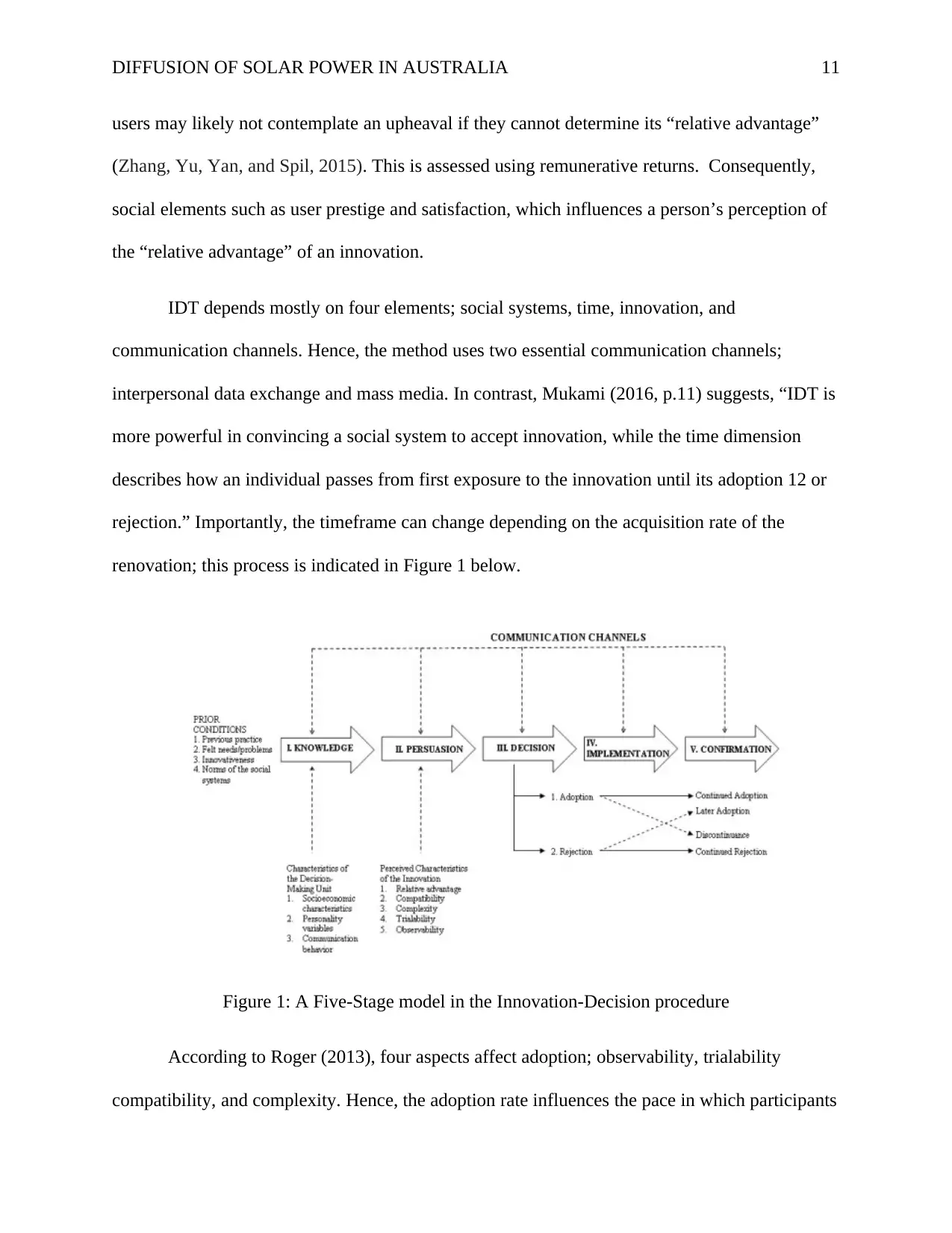
DIFFUSION OF SOLAR POWER IN AUSTRALIA 11
users may likely not contemplate an upheaval if they cannot determine its “relative advantage”
(Zhang, Yu, Yan, and Spil, 2015). This is assessed using remunerative returns. Consequently,
social elements such as user prestige and satisfaction, which influences a person’s perception of
the “relative advantage” of an innovation.
IDT depends mostly on four elements; social systems, time, innovation, and
communication channels. Hence, the method uses two essential communication channels;
interpersonal data exchange and mass media. In contrast, Mukami (2016, p.11) suggests, “IDT is
more powerful in convincing a social system to accept innovation, while the time dimension
describes how an individual passes from first exposure to the innovation until its adoption 12 or
rejection.” Importantly, the timeframe can change depending on the acquisition rate of the
renovation; this process is indicated in Figure 1 below.
Figure 1: A Five-Stage model in the Innovation-Decision procedure
According to Roger (2013), four aspects affect adoption; observability, trialability
compatibility, and complexity. Hence, the adoption rate influences the pace in which participants
users may likely not contemplate an upheaval if they cannot determine its “relative advantage”
(Zhang, Yu, Yan, and Spil, 2015). This is assessed using remunerative returns. Consequently,
social elements such as user prestige and satisfaction, which influences a person’s perception of
the “relative advantage” of an innovation.
IDT depends mostly on four elements; social systems, time, innovation, and
communication channels. Hence, the method uses two essential communication channels;
interpersonal data exchange and mass media. In contrast, Mukami (2016, p.11) suggests, “IDT is
more powerful in convincing a social system to accept innovation, while the time dimension
describes how an individual passes from first exposure to the innovation until its adoption 12 or
rejection.” Importantly, the timeframe can change depending on the acquisition rate of the
renovation; this process is indicated in Figure 1 below.
Figure 1: A Five-Stage model in the Innovation-Decision procedure
According to Roger (2013), four aspects affect adoption; observability, trialability
compatibility, and complexity. Hence, the adoption rate influences the pace in which participants
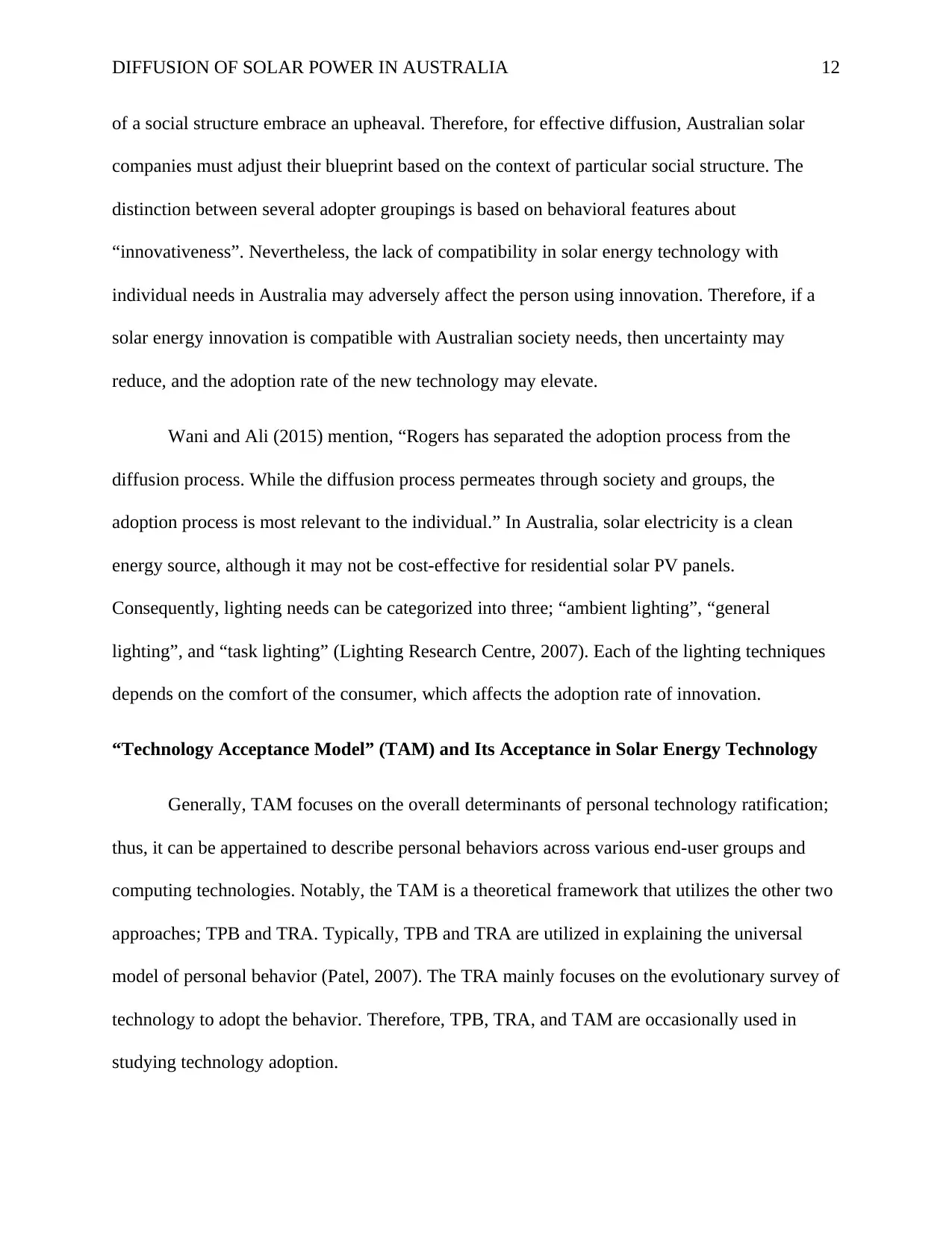
DIFFUSION OF SOLAR POWER IN AUSTRALIA 12
of a social structure embrace an upheaval. Therefore, for effective diffusion, Australian solar
companies must adjust their blueprint based on the context of particular social structure. The
distinction between several adopter groupings is based on behavioral features about
“innovativeness”. Nevertheless, the lack of compatibility in solar energy technology with
individual needs in Australia may adversely affect the person using innovation. Therefore, if a
solar energy innovation is compatible with Australian society needs, then uncertainty may
reduce, and the adoption rate of the new technology may elevate.
Wani and Ali (2015) mention, “Rogers has separated the adoption process from the
diffusion process. While the diffusion process permeates through society and groups, the
adoption process is most relevant to the individual.” In Australia, solar electricity is a clean
energy source, although it may not be cost-effective for residential solar PV panels.
Consequently, lighting needs can be categorized into three; “ambient lighting”, “general
lighting”, and “task lighting” (Lighting Research Centre, 2007). Each of the lighting techniques
depends on the comfort of the consumer, which affects the adoption rate of innovation.
“Technology Acceptance Model” (TAM) and Its Acceptance in Solar Energy Technology
Generally, TAM focuses on the overall determinants of personal technology ratification;
thus, it can be appertained to describe personal behaviors across various end-user groups and
computing technologies. Notably, the TAM is a theoretical framework that utilizes the other two
approaches; TPB and TRA. Typically, TPB and TRA are utilized in explaining the universal
model of personal behavior (Patel, 2007). The TRA mainly focuses on the evolutionary survey of
technology to adopt the behavior. Therefore, TPB, TRA, and TAM are occasionally used in
studying technology adoption.
of a social structure embrace an upheaval. Therefore, for effective diffusion, Australian solar
companies must adjust their blueprint based on the context of particular social structure. The
distinction between several adopter groupings is based on behavioral features about
“innovativeness”. Nevertheless, the lack of compatibility in solar energy technology with
individual needs in Australia may adversely affect the person using innovation. Therefore, if a
solar energy innovation is compatible with Australian society needs, then uncertainty may
reduce, and the adoption rate of the new technology may elevate.
Wani and Ali (2015) mention, “Rogers has separated the adoption process from the
diffusion process. While the diffusion process permeates through society and groups, the
adoption process is most relevant to the individual.” In Australia, solar electricity is a clean
energy source, although it may not be cost-effective for residential solar PV panels.
Consequently, lighting needs can be categorized into three; “ambient lighting”, “general
lighting”, and “task lighting” (Lighting Research Centre, 2007). Each of the lighting techniques
depends on the comfort of the consumer, which affects the adoption rate of innovation.
“Technology Acceptance Model” (TAM) and Its Acceptance in Solar Energy Technology
Generally, TAM focuses on the overall determinants of personal technology ratification;
thus, it can be appertained to describe personal behaviors across various end-user groups and
computing technologies. Notably, the TAM is a theoretical framework that utilizes the other two
approaches; TPB and TRA. Typically, TPB and TRA are utilized in explaining the universal
model of personal behavior (Patel, 2007). The TRA mainly focuses on the evolutionary survey of
technology to adopt the behavior. Therefore, TPB, TRA, and TAM are occasionally used in
studying technology adoption.
⊘ This is a preview!⊘
Do you want full access?
Subscribe today to unlock all pages.

Trusted by 1+ million students worldwide
1 out of 22
Related Documents
Your All-in-One AI-Powered Toolkit for Academic Success.
+13062052269
info@desklib.com
Available 24*7 on WhatsApp / Email
![[object Object]](/_next/static/media/star-bottom.7253800d.svg)
Unlock your academic potential
Copyright © 2020–2025 A2Z Services. All Rights Reserved. Developed and managed by ZUCOL.




